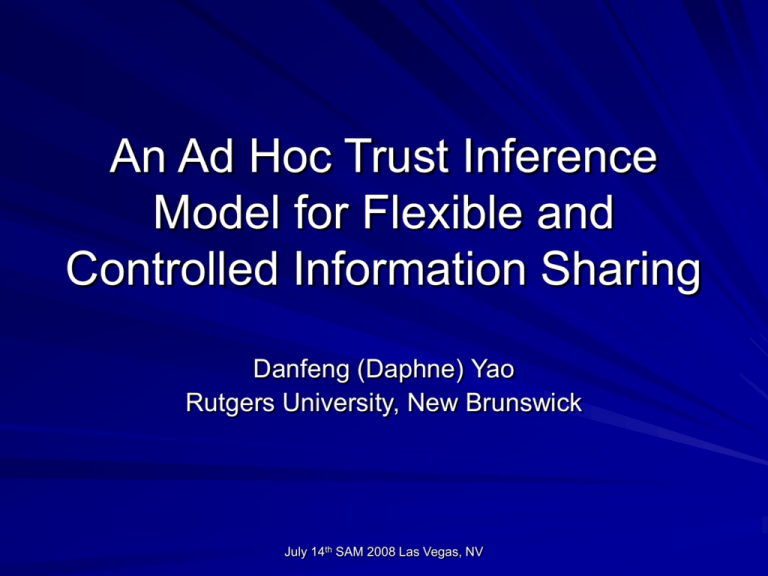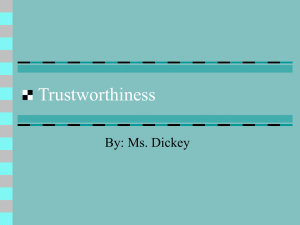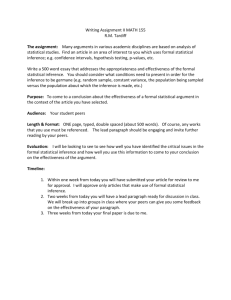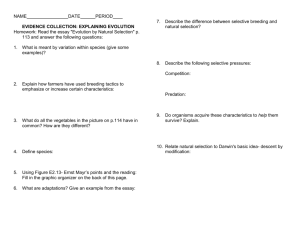fuzzy
advertisement

An Ad Hoc Trust Inference
Model for Flexible and
Controlled Information Sharing
Danfeng (Daphne) Yao
Rutgers University, New Brunswick
July 14th SAM 2008 Las Vegas, NV
Motivation: Hurricane Katrina 2005
Motivation cont’d
Flexible authorization for cross-domain information
sharing
– Traditional access control models are too strict
– Motivating scenario: inadequate crisis communication among
FEMA & Coast Guard after Hurricane Katrina
Need to efficiently share and utilize data generated in
pervasive computing environments
– Sensor data, location, etc
Challenge: there is no central authority in this
decentralized environment
– How does the resource owner adaptively makes access control
decisions in response to emergency situations?
Decentralized trust management
Digital identity and certificate
Is Bob qualified to access DB?
Request for access
Bob’s credential
University
Bob
Policies
Hospital
Most of existing trust management models only work for static
access control policies
– Policies are pre-defined and not adaptive to contexts
– Models cannot handle crisis and emergency situations
Our approach: ad hoc trust inference
– Allow the requester to specify emergency level
– Use fuzzy logic to integrate user information
Broader implication of dynamic
authorization
0
1
Deny
Allow
Useful for flexible information sharing in mission-critical
systems
[JASON Report 04] studied the need for broader access model
Our idea: multimodal authorization
Authorization decisions are made based on multiple
factors including the identity, history, environment
associated with a request.
A requester is given multiple chances of proving
trustworthiness, instead of a type of criteria.
Our ad hoc trust inference model
We introduce attribute urgency level that is to be
specified by the requester
– Urgency level defines how urgent a requester needs the
information
– This attribute is self-claimed by the requester, e.g., urgency level
= very high
– Three attribute types: identity type, history type, and environment
type
We develop a mechanism that combines various
attribute values and outputs a numeric trustworthiness
score for the requester
Our design integrates an audit component in trust
inference
Input attributes in our trust model
Attribute type
Attribute name
Authentication
method
Value range
Identity input
Affiliation
Credential
[0, 1]
History input
Historic
performance
n/a
[0, 1]
Environment
input
Urgency level
Audit
mechanism
[0, 1]
Inference output Trustworthiness n/a
[0, 1]
How does the resource owner combine these attribute values and
obtain the trustworthiness of a requester?
Advantages of ad hoc trust
inference with fuzzy logic
Access policies are intrinsically flexible
– Supports continuous access decisions
– More flexible than binary access verdicts
Access rules are intuitive to define
– Rules are individually defined for each attribute
Can handle incomplete and imprecise inputs
– In decentralized environments, resource owners
usually do not have complete and precise inputs
An example of membership function and
degrees of membership in fuzzy logic
Earliness(time) = { 1,
(2000−time) / 800,
0,
IF time ≤ 1200,
IF 1200 < time ≤ 2000,
IF time > 2000 }
Time of the day
Degree of
earliness
09:00
1
14:00
0.75
16:00
0.5
22:00
0
Trust inference steps
Define attributes from which trustworthiness may
be inferred
Define the fuzzy variables associated with each
attribute
For each fuzzy variable, define a membership
function
Define the output membership function for the
output variable (i.e., degrees of trustworthiness)
Define fuzzy rules to specify the logic used to
infer the trustworthiness score from attributes
Example
Bob from FEMA needs to access US Coast Guard
(USCG) database for a rescue task
– Bob has a FEMA credential
– Urgency level = very high
USCG has prior interactions with FEMA
– Affiliation score = high
– History = very high
– USCG has also defined fuzzy membership functions and fuzzy
rules
Ad hoc trust inference computation produces a
trustworthiness score for Bob’s request
– E.g., trustworthiness = very high
Note that the actual inference is done on crisp inputs and outputs a crisp trust score.
Please refer to the paper for detailed computation.
Architecture
Audit
Urgency level is self-claimed by the requester
and may be inaccurate
Audit process identifies cheating users
– A dishonest user may always claim high urgency level
Audit process selectively examines and verifies
the urgency levels associated past requesters
Dishonest user and organization will have lower
trustworthiness in the future transactions
– Lower affiliation score
– Lower history score
Conclusions and Future work
Conclusions
– Crisis information sharing requires flexible trust
inference mechanism
– We have presented an ad hoc trust inference
framework that allows user-specified context input
Future work
– To automate audit mechanism by analyzing public
and sensory information
– To apply ad hoc trust inference mechanism to
manage trust in Web 2.0 applications
Acknowledgements
Professor James Garnett, Rutgers University
Department of Public Policy and Administration
Funding: Rutgers University Computing
Coordination Council (CCC) Pervasive
Computing Initiative Grant






